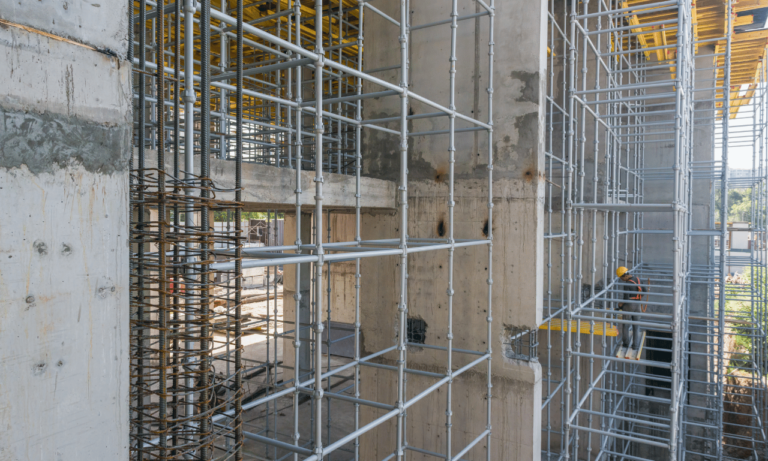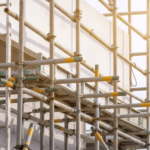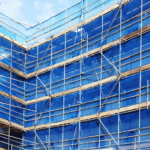Phone:
(+65)8319-0742
The construction world has changed a lot with prefabricated components. This change brings us into a new era of efficient construction solutions. Prefabrication makes building faster and cheaper. It also makes sure projects meet deadlines and save money.
By making parts off-site, these cost-effective prefabricated structures speed up building time. They also make sure the final building is of high quality. This helps avoid delays caused by bad weather.
Key Takeaways
- Significant shift towards prefabrication boosting construction efficiency and speed.
- Controlled environment of off-site production enhances quality control.
- The Growing Importance of Prefabricated Components in Construction Scaffolding
- Prefabricated structures reduce reliance on weather conditions during construction.
- Customization of prefabricated components suits specific project needs and design.
- Rigorous quality checks ensure adherence to industry standards.
- Efficient utilization of materials and standardized processes lower overall costs.
- Robust collaboration across disciplines necessary for optimal prefab integration.
Introducing Prefabrication in Construction
Prefabrication is changing the way we build, moving towards more efficient and green construction. It uses offsite units, factory-made parts, and modular pieces. This new approach is making building faster and greener.
The Emergence of Offsite Construction Units
Offsite construction units are key to modern prefabrication. They let builders make building parts in a controlled place. This makes building faster and more precise, cutting down on site problems and environmental harm.
More builders are using these methods because they work well and are good for the planet. This fits with sustainable building practices.
Benefits of Moving to Factory-Made Construction
Building parts in a factory means no worries about the weather or site issues. This cuts construction time in half and reduces the need for skilled workers on site. It makes better use of resources and cuts down on waste.
Enhancing Quality Through Controlled Environment Production
Building in a controlled setting means better quality parts. Parts like panels and modules are made in a stable place, so they’re more consistent. This also lets builders use new tech in making things, like power scaffolding.
| Material | Use in Prefabrication | Benefits |
|---|---|---|
| Wood | Lightweight structures, easy transport | Cost-effective, sustainable |
| Steel | High-rise modular buildings | Durable, supports advanced structural systems |
| Concrete | Core structures in modular construction | Robust, enhances longevity |
The Advantages of Prefabricated Components in the Construction Industry
Prefabricated structural elements have changed the construction world. They make building projects more efficient and offer modular construction benefits. These elements are changing how buildings are built, making them faster and with less waste.
Using sustainable building materials, prefabrication is good for the planet. It cuts down on waste and reduces disruptions like noise and traffic. This leads to smoother and quicker projects.
- Prefabrication lowers material costs and minimizes wastage, making operations more economically and environmentally sustainable.
- The ability to combine prefab elements with cutting-edge technology such as 3D modeling and Building Information Modeling (BIM) enhances the precision in construction.
- Modular construction allows for flexible design and easy expansion, facilitating future modifications without extensive additional costs or efforts.
Adding prefabricated elements to modular construction benefits speeds up building and keeps quality high. Each part is made in a controlled place, ensuring quality and fewer mistakes.
| Feature | Advantage |
|---|---|
| Reduced Construction Time | Time savings up to 50% compared to traditional methods |
| Environmental Impact | Lower ecological footprint, materials are recyclable |
| Cost Effectiveness | Potential reduction in total project costs due to efficiencies and economies of scale |
| Quality Assurance | Components checked for quality standards before site delivery |
The global market for prefabricated buildings is expected to hit about $153 billion by 2026. This shows a big move towards more sustainable building materials and methods. Prefabrication’s benefits, like saving money, protecting the environment, and improving efficiency, are key to the construction industry’s growth.
The Strategic Advantages of Prefabricated Components in Construction Scaffolding
The construction industry continuously seeks innovations that enhance efficiency, improve safety, and reduce costs. One such innovation is the use of prefabricated components in scaffolding, which has revolutionized traditional building methods. These components, pre-assembled in a controlled factory environment, offer a multitude of strategic benefits that are reshaping construction practices.
Streamlined Construction Process
Prefabrication of scaffolding components allows for a more streamlined construction process. Unlike traditional scaffolding, which requires on-site assembly involving multiple manual tasks (measuring, cutting, fitting), prefabricated scaffolding can be quickly erected with minimal labor. This is due to the standardized interlocking features of the components, which are designed for rapid assembly and disassembly. Such efficiency not only speeds up the project timelines but also reduces labor costs significantly.
Rigorous Safety Enhancements
The safety benefits of using prefabricated scaffolding components cannot be overstated. Each component is manufactured to adhere to stringent safety standards and is subjected to quality control checks that might be unfeasible in typical on-site constructions. This controlled manufacturing process helps in mitigating risks associated with human errors such as improper assembly or the use of flawed materials. Furthermore, the inherent stability and reliability of these components contribute to safer working conditions for construction workers.
Economic Efficiency Through Reusability
Initially, prefabricated components might present a higher upfront cost compared to traditional materials. However, the economic efficiency becomes evident through their reusability and reduced assembly times. The durable nature of these components allows them to be reused across multiple projects, diminishing the cost per use. Additionally, the decreased dependency on skilled labor for assembly and the shorter project durations translate into substantial cost savings over the lifecycle of the scaffolding.
Reduced Environmental Footprint
Environmental sustainability is another significant advantage of prefabricated scaffolding components. The production process in a factory setting allows for better waste management and recycling practices, reducing the environmental impact associated with scrap and unused materials. Furthermore, the precision in manufacturing ensures optimal material usage, preventing the excess that often occurs in traditional scaffolding setups.
Adaptability and Customization
Modern prefabricated scaffolding systems are highly adaptable, contradicting the common misconception that prefabricated means “one size fits all.” These systems can be customized to meet specific project needs, supporting a range of architectural designs and load requirements. This flexibility is crucial for projects with unique structural challenges, proving that prefabricated scaffolding can be as versatile as it is efficient.
Expert Insights: Modern Applications of Prefabricated Components
Today, prefabricated building blocks are key to making construction faster and more efficient. They help reduce delays in busy cities and make big projects go smoother. These systems are used in many ways and are always getting better.
The Role of Prefabricated Components in Residential Developments
Residential buildings are changing thanks to prefabricated components. They make building faster and ensure higher quality. This means projects finish quicker, cost less, and are better for the planet because they produce less waste.
More and more, prefab is being used in homes and apartments. It’s chosen for its efficiency and eco-friendliness.
Commercial Construction: Prefabricated Components at the Forefront
In commercial projects like offices, schools, and hospitals, speed is crucial. Prefabricated components help by cutting down construction time. This means businesses can open sooner, which is good for their bottom line.
For example, projects by Rosettee Construction show how prefab helps with local work and quick completion.
Accelerating Infrastructure Projects with Prefab Technology
Using prefabricated components speeds up building infrastructure like bridges and highways. It’s cheaper and doesn’t disturb the public much. Prefab has been used in many projects, showing it can meet tight deadlines and stay within budget.
| Project Type | Time Savings | Cost Efficiency | Environmental Impact |
|---|---|---|---|
| Residential Buildings | Up to 50% faster | Reduces overall cost by 20% | 83.2% less waste |
| Commercial Buildings | 45% increase in speed | 30% cost reduction | Reduces CO2 emissions |
| Infrastructure | Accelerated by 60% | Up to 40% cost savings | Less on-site pollution |
The Efficiency of Modular Elements in Building Construction
Modern building methods use modular elements a lot. This approach is great because it uses offsite fabrication. These prebuilt units make building faster by making the process simpler.
By sending parts made in a controlled place straight to the building site, the building process gets easier. This cuts down on the problems of traditional building. It makes building faster and uses less labor, which is important because there’s a shortage of skilled workers.
These modular systems are quick to adapt to what’s needed and save up to 10% by being more predictable with costs, as shown here. Making parts offsite also cuts down on mistakes and waste, saving 7-8% on project costs.
In Europe, many countries are using these prefabrication methods. Germany, for example, built about 25,000 prefabricated units in 2017. North America is also starting to use modular solutions more for permanent buildings.
Building modules offsite ensures they meet high safety and quality standards. These units are built to strict building codes and are better for the environment. They use eco-friendly materials and create less waste.
The table below shows how modular construction has big benefits, proving its growing importance in building.
| Benefit | Impact | Statistic |
|---|---|---|
| Cost Savings in Project | Reduce overall project costs by minimizing errors and bulk material purchases | 7-10% cost reduction |
| Waste Reduction | Minimizes excess materials through precision and pre-measurement | Approximately 7-8% savings |
| Time Efficiency | Speeds up construction process, reduces interim financing | Fast construction timelines |
| Safety and Compliance | Enhanced safety protocols and conformity to building regulations | Improved safety records, complies with standards |
Using fast-track building solutions with modular elements and offsite fabrication helps solve today’s building challenges. It’s a key method in today’s changing building world, as explained in a detailed article on modern prefabrication.
Customizable Building Blocks: Tailoring Prefab for Unique Projects
The use of customizable building blocks and tailored prefab solutions is changing the construction world. It makes projects efficient and perfect for specific needs. This change comes from the great work of designer-manufacturer collaboration. It ensures each project gets unique prefabricated construction systems.
Collaboration Between Designers and Manufacturers
Designers and manufacturers working together is key to prefab success. This team makes buildings efficient, cost-effective, and adaptable. Designers join in early to make sure prefab fits the project’s style and what the client wants. This makes customizable building blocks more flexible and useful.
Innovative Solutions with Customized Prefabrication
Tailored prefab solutions are more than just good looks. They focus on being efficient, green, and fitting the project. With tech like 3D printing and robots, they make parts that match any project’s shape. This cuts down on waste, makes logistics easier, and keeps construction sites safer.
Adapting Prefab Elements to Diverse Construction Needs
Unique prefabricated construction systems can be used in many areas, like homes, offices, and public buildings. They make sure each building works well, lasts long, and is built fast and cheap. This approach cuts down on construction time and costs.
| Feature | Benefit |
|---|---|
| Reduced Construction Timeline | Speeds up building, less waiting for good weather. |
| Optimized Material Use | Less waste with pre-cut parts, less waste on site. |
| Enhanced Job Site Safety | Less work on site means fewer risks, safer place. |
| Design Flexibility | Makes it easy to change or add things as needed. |
| Cost Efficiency | Needs less skilled workers and fewer mistakes in building. |
| Sustainability | Using lighter, greener materials lowers environmental harm. |
By working together, designer-manufacturer collaboration brings big benefits to the construction world. Customizable building blocks and tailored prefab solutions make building faster, more creative, and better for the planet.
Construction System Components: Breaking Down the Basics
The use of factory-built components, pre-finished building modules, and assembly-ready parts is changing how we build today. These construction system components make building faster by using prefabrication. This is a big change from old building methods.
Building parts like roof trusses, wall panels, and staircases in factories helps make building faster and more precise. These parts are made in controlled places, ensuring they meet high quality standards before being used. This precision is key for putting together different parts smoothly, as shown in the guide on precast concrete structures.
Using pre-finished modules in tight city spaces reduces waste and storage needs. It also helps in making buildings more sustainable. Using prefab parts like modular facades and MEP systems cuts down on waste and site disruptions. This is a big step towards green building.
The construction industry has seen a big change with prefab techniques. These methods improve site efficiency, increase safety, and lower costs by using specialized labor in controlled places. Making construction system components off-site means building faster, which means projects finish quicker and people can move in sooner.
The impact of factory-built components and assembly-ready parts is huge for construction. This approach helps manage resources better and builds structures that are strong, green, and efficient. It shows the big benefits of prefab in building modern infrastructure.
Engineering Meets Construction: Pre-engineered Sections vs. Traditional Building
The construction world has changed a lot, thanks to engineering construction integration. This change comes from using pre-engineered sections. Moving from traditional vs prefab construction makes building better and leads to better results. Let’s see how these new ways compare to old methods and their cost benefits.
Building Systems and Their Components
Pre-engineered buildings use top-quality steel and precise engineering. They make parts that are both strong and light, unlike traditional materials. These buildings have special frames and sections that are easy to move and make the building strong against earthquakes.
The Shift from Traditional Methods to Pre-engineered Solutions
Switching to pre-engineered sections is because they can be made with advanced software. This makes building consistent and precise, unlike the old ways which were often slow and varied. Also, making these parts in a factory cuts down on building time and mess.
Cost Analysis: Prefabrication vs. Conventional Construction
Choosing cost-effective prefab construction has many financial benefits. Pre-engineered buildings are 20-30% lighter than old ones, which makes the foundation easier and cheaper. They also save on labor and setting up costs. Making parts in a factory cuts down on labor costs and waste, saving money and being better for the planet.
For more details on modular and pre-engineered buildings, check out this detailed analysis here.
Using pre-engineered buildings makes building faster, stronger, and cheaper. It’s great for industrial, infrastructure, or storage projects. These buildings are designed to meet today’s needs well, showing a complete approach to engineering construction integration.
Navigating the Complexities of Off-site Construction
Off-site construction is changing the way we build, making it more sustainable and efficient. It’s important to understand its challenges and how to manage them. This means looking at logistics, prefab challenges, and how to install factory-built parts easily.
Logistics and Transportation of Factory-Built Components
Getting factory-built parts from the factory to the building site is key to off-site construction’s success. It’s not just about moving parts, but making sure they arrive in perfect condition. This can be tricky, especially with big or odd-shaped parts that need special care.
Installation Techniques for Rapid Assembly
Once parts arrive, it’s time to put them together quickly and correctly. The right installation methods keep the design strong and the project on track. Getting the foundation ready is crucial since prefab parts fit very precisely.
Planning and teamwork help speed up the assembly. This way, the team can tackle any unique challenges fast.
Addressing Challenges in Prefabricated Construction Systems
Overcoming prefab challenges requires a detailed plan. This includes looking at rules, supply chains, and working together with different groups. Off-site construction uses new standards to keep things consistent everywhere. This makes things easier for everyone involved.
By tackling these issues well, we can enjoy the benefits of off-site construction. These include less environmental impact, lower costs, and being more sustainable. This leads to better quality and faster project completion, making everyone happy.
Conclusion
The journey through prefab construction innovation shows us a future where building is more efficient and refined. Prefabrication is changing the building industry for the better. It’s making building smarter and more sustainable.
More and more, we’re seeing prefab parts being used in buildings, from walls to stairs. This is true for both homes and public buildings. The use of advanced tech like CAD and BIM makes prefab materials a top choice for builders. They love prefab for its cost savings and quick setup.
But, prefab construction isn’t without its challenges. It needs good planning and quality control to work well. New tools like component explorers help make building more efficient. This leads to lower labor costs, better material use, and safer sites.
Looking ahead, prefab construction is set to grow big. It will change how we build and live in spaces. The hurdles it faces, like better planning, will lead to even better prefab solutions. With advanced planning and tech, the future looks bright for prefab.
So, prefab construction is writing a new story in building innovation and excellence.

























